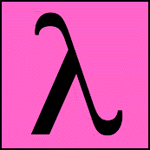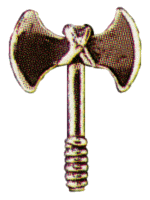By Heze Douglas
We often illustrate our identities with symbols, to locate ourselves, and to find our kindred. The bi-flag was born 7 years ago and has given us a new alternative to wrap about our bodies if we so choose. Given its young life and somewhat limited visibility, I don’t think I’ve actually laid my eyes on one “in the flesh.” To be fair though, I’m sure they have been toted through my hometown streets during Pride, at least. I dare say past my very nose, but I was probably too busy checking out all the cute ladies and gents to register this colourful swath. I can almost hear myself thinking “Hmm, that pink, purple and blue flag is a pretty version of the Pride flag…” and not taking the thought one step further. This made me wonder if others know about the bi-flag? Is it unknown, unrecognized, and unappreciated? Who does befriend this symbol and what does it mean to them?
Historically there have been many symbols adopted and used to identify different sects of queer culture. Some of these have been rejected as they have become dated or revealed as controversial. Certain picks are more visible than others, more desirable, more marketable. There are those of us who create our own symbols, not available for mass marketing, nor mass recognition, and those of us who reject all symbols of identification.
Throughout time queers have had symbols pinned to them against their will, and chosen to pin themselves with symbols. Peering back to the dark days prior to WW II, Hitler was rapidly gaining power, writing laws and creating his reign of terror. He made all forms of homosexuality illegal, including erotic dreams. During the war he put his law into practice and homosexual men were marked with a pink triangle upon arrest. Women who were known as feminists, lesbians, or prostitutes were marked with a black triangle. These symbols have been reclaimed to draw attention to past and present persecution, and to defy historical denial.
The Lambda symbol was adopted in the early 70’s by New York’s Gay Activist Alliance. This lowercase Greek L is associated with liberation. To the Spartans it resembled unity. And the Romans adopted the letter to mean “the light of knowledge shed into the darkness of ignorance.” The chemists and physicists use the Lambda to connote charged energy, me-ooow! In the past sporting the Lambda allowed you to breeze by gay bashing frat boys who would easily mistake it for a college frat symbol while your fellow gays could identify you with it. This is one of the more controversial numbers.
A ladies pick has been the double-edged hatchet, known as the Labrys. It was used as a symbol of feminist and lesbian strength and self-sufficiency. Word has it most feminists eventually dropped the symbol leaving it for the lesbians. I can picture the labrys hugging the strong neck of my beloved past classmate, an old school lesbian.
The early 70’s also introduced the gender symbols for identity purposes, displaying either your sexuality or gender. The two interlocking male symbols for the gay boys, while the lesbians proudly started interlocking two female symbols. Trans people merged the cross and the arrow on the same ring. Another symbol used in the trans and intersex communities is the mercury symbol. This has a cross extending down to represent femininity and a crescent moon at the top to represent masculinity.
The symbol most recognized by us modern queers is the rainbow flag. San Franciscan artist, Gilbert Baker, designed this flag and took it to Pride in 1978. It started out as 8 colours representing the various components of our culture: hot pink=sex, red=life, orange=healing, yellow=sun, green=nature, turquiose=art, indigo=harmony, violet=spirit. In its 1979 mass production pink and turquoise were dropped as they weren’t commercially available colours, and royal blue replaced indigo. Drop pink and turquoise? Sex and art? Maybe that’s why the current rainbow flag doesn’t resonate with me. In any case this six colour version has become visible like hickies the morning after a high school dance and is known as the symbol of gay pride and diversity. Although I don’t drape myself with this symbol I must admit if I’m going to an establishment outside of the queerborhood I do feel more at ease if the door is marked with the rainbow sign. And I tend to peer more curiously into cars I pass on the highway sporting the rainbow stripe.
Then along came Michael Page. He feels that none of these symbols speak specifically to bisexuals. Upon talking to other bisexuals and searching his own experience he concluded that bi people need their own “flags and symbols to rally around.” In existence at this time were the bi-angles, the interlocking pink and blue triangles merging into purple. Page drew from these colours to design the bisexual flag. The top 40% of the flag is pink, the bottom 40% is blue, and the 20% midsection is purple. “The pink colour represents sexual attraction to the same sex (gay and lesbian), the blue represents sexual attraction to the opposite sex only (straight) and the resultant overlap purple represents sexual attraction to both sexes (bi). The pixels of colour blend unnoticeably into both the pink and blue, just as in the ‘real world’ where most bi people blend unnoticeably into both the gay/lesbian and straight communities.” This flag was unveiled on Dec.5, 1998.
“The intent and purpose of the flag is to maximize bisexual pride and visibility,” says Page. For journalistic purposes I called upon my sweet Saturday night date to drive us up and down the local queer neighborhood in search of such a flag. I felt like we were cruising the drag reminiscent of lost youth looking for action. None was to be found. Not a single bi-flag was flying in one of the world’s biggest queer villages. Not even a sticker pressed to a steamy window. I must note here that the lack of rainbow flags and signage surprised me too. Although they did exist there were less than I had imagined. Maybe it’s redundant in an already queer-identified neighborhood? I took my search a little further and checked some local queer run/friendly book and sex shops outside said neighbourhood. Nary a bi-flag anywhere. Ah, dear. I did however witness some bi-flag visibility when I searched Page’s Bi-Flag website. He has compiled pictures from international events that did have the bi-flag present. We see it flapping in the wind, and held in smiling hands at Pride celebrations in Florida, Rome, New York, and Reykavik Iceland. Not to mention various bisexual conferences, events, and activist happenings that have taken place since 1998. To learn more about Michael Page’s bi-flag endeavors go to: www.biflag.com
I decided to take a poll from a few bi-identified pals. “Are you familiar with the bi-flag?” A couple of respondents had never heard of it, while another was familiar with the bi triangles, and one had to check her fridge magnet to be sure.
“Do you identify with the bi-flag more than other queer symbols?”
-“My short answer is no, I don't identify with the bisexual pride flag. I don't like how gendered it is.”
-“I don’t identify with any queer symbols.”
-“I prefer the rainbow because it’s more representative of varied queer identities, not that I’m very drawn to the rainbow either.”
- “No, but could if I knew more about them.”
The final question “Would you buy, make, or wear any bi-gear?” got one yes, one no, one “maybe just for Pride, but probably not” and “I would never because my sexuality should be more subtle than symbolism.” Finally my pal Dez states that he really wants bi-coloured parachute pants with “One leg for the ladies, and the other for the gents.” Obviously this is just one small pocket of people, and we all need to find our own identities, their markers, and expression of these. I do not harbour any ill feelings towards those who deck themselves out in colours or symbols of choice. Myself, I’d have to say the only flag I need to wave is my panties at the boy or girl who has caught my eye. Or if I’m in the mood a little hanky coding a la navy blue, red, or houndstooth can complete my outfit with a dash of confidence and a splash of solidarity to my community and myself. But hey, chacun son gout and cada su propio.
If you’re up for some bi-gear why not whip up a little something? If you aren’t the crafty type there are no shortage of shops on-line and otherwise waiting to take cash off your hands and proudly deck you out in pink, blue, and purple. When browsing for availability I came across flags, key chains, posters, necklaces, stickers, pins, magnets, bracelets, and bookmarks. My personal favorite was the pin “Bi – twice as likely to have a date this weekend.” Ah, if only that were true…
www.biresource.org
www.biprideshop.com
www.bipridestore.com
www.desertpride.com
www.outsidethelines.biz
There you have it folks. Throughout history people have been eager to brand themselves and others through recognizable symbols. The bi-flag was born in wake of this movement and its lovely colours, and intentions are worming their way into many a bisexual heart. Others can leave them be. Will this flag become as recognized and appreciated as other queer signifiers have? Will it draw together in strength and celebration the solo shooters and gangs of bisexuals who are looking for each other? It just may. Is it for all of us? Does it need to be? Hey you already know what kind of flag I’m waving, and I’m happy with those panties of mine.









 Reply With Quote
Reply With Quote















Bookmarks